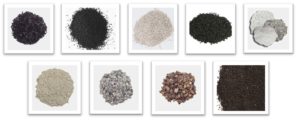Whether it is for chlorine removal, iron and manganese oxidation, or pH correction and acid neutralization there are dozens of different media for all types of filtration. In this post, we will explore the different types of media and minerals used in our filtration units.

Top Row (Left to Right): Carbon, Birm, Filter Ag, Manganese Greensand Plus, Calcite Bottom Row (Left to Right): Magnesium Oxide, NS & Extra-Strentgh NS-Mix, pH++, Simplus
Carbon
Carbon has been used for filtration and purification for thousands of years. Depending on the type, carbon is used for adsorption, absorption, or as an oxidation catalyst. Source material for activated carbon media includes bituminous and anthracite coal, bone char, coconut shell, lignite, peat, and wood. These source materials are crushed, sized and processed with intense heat to create what is known as activated carbon. Activated carbon removes contaminants through adsorption of contaminants onto the surface and pores of a carbon granual. These activated carbon granuals are porous and have an extensive internal and external structure of activation sites. The most common types of activated carbon used in water treatment are the granular and powdered forms. Powdered activated carbon is used in many carbon block filters and point of use filters. Granular activated carbon is most common in point of entry backwashing and flow through filter systems. Activated carbon is often used to improve the taste and odor of water. Applications include the removal of hydrogen sulfide, chlorine and chlorine reduction, MTBE and PFAS removal. The ability of activated carbon to both adsorb and absorb makes it one of the best filter media in the water treatment industry. The only regeneration needed is backwashing and rinsing. No chemical regenerants are needed.
Birm
Birm is a granular filter media used to remove Iron and Manganese from the water supply. Birm can only be used on water with a neutral pH. Master Water Conditioning uses Birm to filter out ferric hydroxide (precipitated) and manganous manganese (precipitated). We always recommend that a water softener be installed after the filter to remove any ferrous bicarbonate and/or manganese that the Birm filter did not filter out.
Birm has a sacrificial coating material that acts as an insoluble catalyst to create a reaction between the dissolved oxygen and the iron and/or manganese in the water supply. This action causes the iron and/or manganese to be oxidized and then filtered out through the Birm. If any iron and/or manganese is present after the Birm filter, it will be in the Ferrous Bicarbonate and/or Manganese form and can easily be removed with a water softener. The only regeneration needed is backwashing and rinsing. No chemical regenerants are needed.
Filter Ag
Filter Ag or Filter Aggregate is a lightweight granular type filer material used to remove turbidity from the water. Filter Ag can remove particles with a size as small as 20 microns. Filter Ag is more superior than sand for sediment removal because Filter Ag is lighter in weight which requires less water for regeneration. The only regeneration needed is backwashing and rinsing. No chemical regenerants are needed.
Manganese Greensand Plus
Manganese Greensand Plus is a granular filter material used for the removal of Iron, Manganese and Hydrogen Sulfide. Manganese Greensand Plus is a specific sand that is coated with a catalyst material. The Manganese Greensand uses this coating to react with iron, manganese and hydrogen sulfide in the water to create a precipitate which then is trapped in the filter media. Manganese Greensand Plus must regenerate with chlorine to disinfect and clean the media during backwash. We always recommend that a water softener be installed after the filter to remove any ferrous bicarbonate (clear) Iron that the filter missed. Manganese Greensand Plus will also remove a limited amount of Hydrogen Sulfide. However, we only recommend Manganese Greensand Plus for Hydrogen Sulfide removal on special water problems.
Calcite
Calcite is a crushed and carefully screened white calcium carbonate, marble looking material that is used to increase the alkalinity, thereby increasing the pH of the water supply. Increasing the pH will eliminate the corrosiveness of the water supply. Calcite dissolves into the water to increase the pH, but as a result also increases the hardness of the water. Because calcite is sacrificial due to its dissolving nature, it must be added periodically. Since the calcite filter increases hardness, a water softener is recommended. Calcite is also an excellent material for the removal of ferric hydroxide (cloudy) Iron. A water softener is installed after the calcite filter to remove the hardness and any ferrous bicarbonate that the calcite filter missed. The only regeneration needed is backwashing and rinsing. No chemical regenerants are needed.
Magnesium Oxide (Corosex)
Corosex is a very concentrated form of magnesium oxide that is always blended with calcite to reduce the risk of cementing. We call this blend of Corosex and Calcite, NS Mix. The NS Mix increases the alkalinity of the water to raise the pH value to a neutral state (7.0).
The NS Mix can raise a pH from 5.5 to 7.0 (neutral), and is recommended on any water that has a pH between 5.5 and 6.0. Corosex has the same regeneration and sacrificial properties as Calcite.
NS-Mix
NS Mix is a blend of 80% calcite and 20% magnesium oxide for use in applications where the pH level is between 5.5 and 5.9. This media will diminish in volume over time as it raises the pH of the water supply and must be replenished every 3 to 6 months. A water softener should be installed after an acid neutralizer using this type of media in order to remove the added hardness.
Extra-Strength NS-Mix
NS Mix Extra Strength is a blend of 60% calcite and 40% magnesium oxide for use in applications where the pH level is between 5.0 and 5.8. This media will diminish in volume over time as it raises the pH of the water supply and must be replenished every 3 to 6 months. A water softener should be installed after an acid neutralizer using this type of media in order to remove the added hardness.
PH++
PH++ is a crushed and carefully screened magnesium that is used to increase the alkalinity, thereby increasing the pH of the water supply. Increasing the pH will eliminate the corrosiveness of the water supply. PH++ is a much stronger pH corrector than NS-Mix or Calcite and should only be used if these media have failed to correct the pH. We recommend that you consult the factory for specific usage parameters. PH++ dissolves into the water to increase the pH, but as a result also increases the hardness of the water. Because PH++ is sacrificial due to its dissolving nature, it must be added periodically. Since the PH++ filter increases hardness, a water softener is recommended. The only regeneration needed is backwashing and rinsing. No chemical regenerants are needed.
Simplus
Simplus is a granular manganese oxide filter material used for the removal of hydrogen sulfide and trace levels of iron. It can only be used on water that has a pH in the 6.8-7.8 range. Simplus acts as a catalyst to create a reaction between dissolved oxygen and the hydrogen sulfide. We always recommend that a water softener be installed after the filter if iron or manganese is present. Simplus can be regenerated with sodium hypochlorite (5.25% bleach) to clean precipitate from the filter material. Otherwise, regeneration included backwashing and rinsing.
Multi-Media
Muti-media is a combination of medias used in our multi media filters designed for a 10 micron filtration and turbidity reduction. Multi media is heavier in total weight and requires strong backwashing to lift and rinse the bed. While the multi media in tanks can vary depending on the application and the contaminants targeted for removal, we recommend a mix (from bottom to top) of gravel, #1 sand, #0 sand, #45 sand, #0 sand, and philterkol. Over time the media will separate and stratify based on density and particle size.









